
California mixed evergreen forest is a plant community found in the mountain ranges of California and southwestern Oregon.

Adelpha californica, the California sister, is a species of butterfly in the family Nymphalidae. They are common in California, but can also be found in western Nevada and Oregon, as well as in northern Baja California. The upper surfaces of their wings are dark brown to black with wide cream white bands dissecting both wings and two orange patches near the tips of the forewings. The underside is variously colored with browns, blue, orange, and white. A. californica is unpalatable to predators and is part of a large mimicry complex.
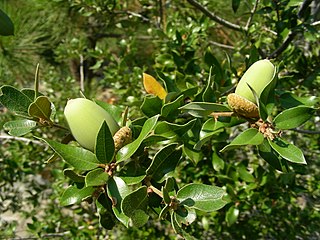
Quercus chrysolepis, commonly termed canyon live oak, canyon oak, golden cup oak or maul oak, is a North American species of evergreen oak that is found in Mexico and in the western United States, notably in the California Coast Ranges. This tree is often found near creeks and drainage swales growing in moist cool microhabitats. Its leaves are a glossy dark green on the upper surface with prominent spines; a further identification arises from the leaves of canyon live oak being geometrically flat.
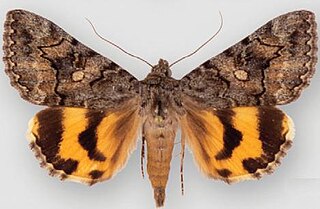
Catocala mcdunnoughi, or McDunnough's underwing, is a moth of the family Erebidae. The species was first described by Auburn Edmund Brower in 1937. It is found in the US state of California.
Neocrania is a genus of moth of the family Eriocraniidae. It contains only one species, Neocrania bifasciata, which is found in the Coast Ranges of southern California.

Acleris semipurpurana is a species in the moth family Tortricidae, and one of several species of moth commonly known as oak leaftier or oak leaf tier. The larvae feed on the leaves of oak trees in the Eastern United States and southeastern Canada which can be a major cause of defoliation. The loss of leaves can kill or damage the affected trees, which are chiefly in the Lobatae or red oak section of Quercus, or oaks.
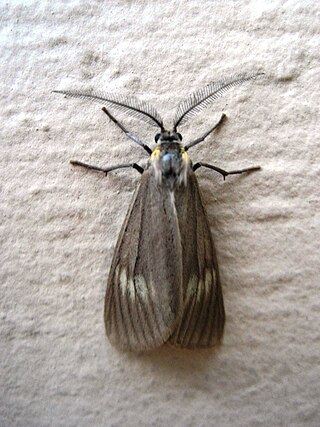
Phryganidia californica, the California oakworm or California oak moth, is a moth of the family Notodontidae. The species was first described by Alpheus Spring Packard in 1864. It is found along the coasts of the US states of California and Oregon.

The European oak leaf-miner or Zeller's midget is a moth of the family Gracillariidae. It is found in Europe south of the line running from Ireland, through Great Britain, Denmark to Ukraine. It is also found in Macaronesia. It is an introduced species in New Zealand and Australia.

Cameraria leucothorax is a moth of the family Gracillariidae. It is known from California and Oregon in the United States.
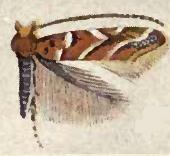
Cameraria agrifoliella is a moth of the family Gracillariidae. It is known from California, United States, and British Columbia, Canada.
Acrocercops insulariella is a moth of the family Gracillariidae. It is known from the United States (California).
Ypsolopha cervella is a moth of the family Ypsolophidae. It is found from Vancouver Island southward along the Pacific coast to San Diego County in California and inland to Arizona.

Agrilus auroguttatus is a species of jewel beetle in the United States, known by the common name goldspotted oak borer. It is not native to California, but is native to Arizona. It is a woodboring beetle best known for destroying stands of oak trees in the Cleveland National Forest in San Diego County, California, in the United States. The distribution of this insect in California can be found at CalInvasive website. It was originally considered a subspecies of the Central American species Agrilus coxalis, and much of the literature refers to it by this name, but now it is regarded as a separate species, known only from Arizona and California.

Dyseriocrania auricyanea is a moth of the family Eriocraniidae. It was first described by Baron Walsingham in 1882 and is found in California.
Eriocraniella falcata is a moth of the family Eriocraniidae. It was described by Davis in 1978. It is found in the Coast Ranges of central California.
Eriocraniella mediabulla is a moth of the family Eriocraniidae. It was described by Davis and Faeth in 1986. It is found in northern Georgia, northern Florida, southern Louisiana, north-eastern Texas, and North Carolina.

Rectiostoma xanthobasis is a species of moth in the family Depressariidae. It was described by Philipp Christoph Zeller in 1876. It is found along the Atlantic Coastal Plain from south-eastern Massachusetts south to central Florida and eastern Texas, and north in the Mississippi Valley to Missouri and Illinois.
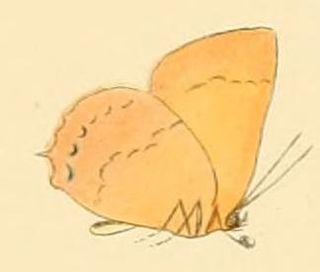
Habrodais grunus, the golden hairstreak, is a butterfly in the family Lycaenidae. It is found in North America in southern Arizona, Oregon, California and Mexico. The habitat consists of oak woodland, canyons and mountain ridges.
Stilbosis dulcedo is a moth in the family Cosmopterigidae. It was described by Ronald W. Hodges in 1964. It is found in North America, where it has been recorded from California and Arizona.
Chionodes messor is a moth in the family Gelechiidae. It is found in North America, where it has been recorded from Nevada and California.









